Authentic German Sauerbraten
This post may contain affiliate links. See my disclosure policy.
One of Germany’s national dishes, this authentic German Sauerbraten features beef roast that is marinated, cooked until fork tender, and served with a wonderfully rich and flavorful sweet-tangy gravy! Serve it with the traditional sides of Rotkohl, potatoes, Semmelknödel, Kartoffelklöße, or Spätzle for a hearty and thoroughly satisfying and unforgettable meal. And whether you’re serving it for a special occasion, casual family gathering, or as part of your Oktoberfest dinner, you’re all set for a memorable feast!
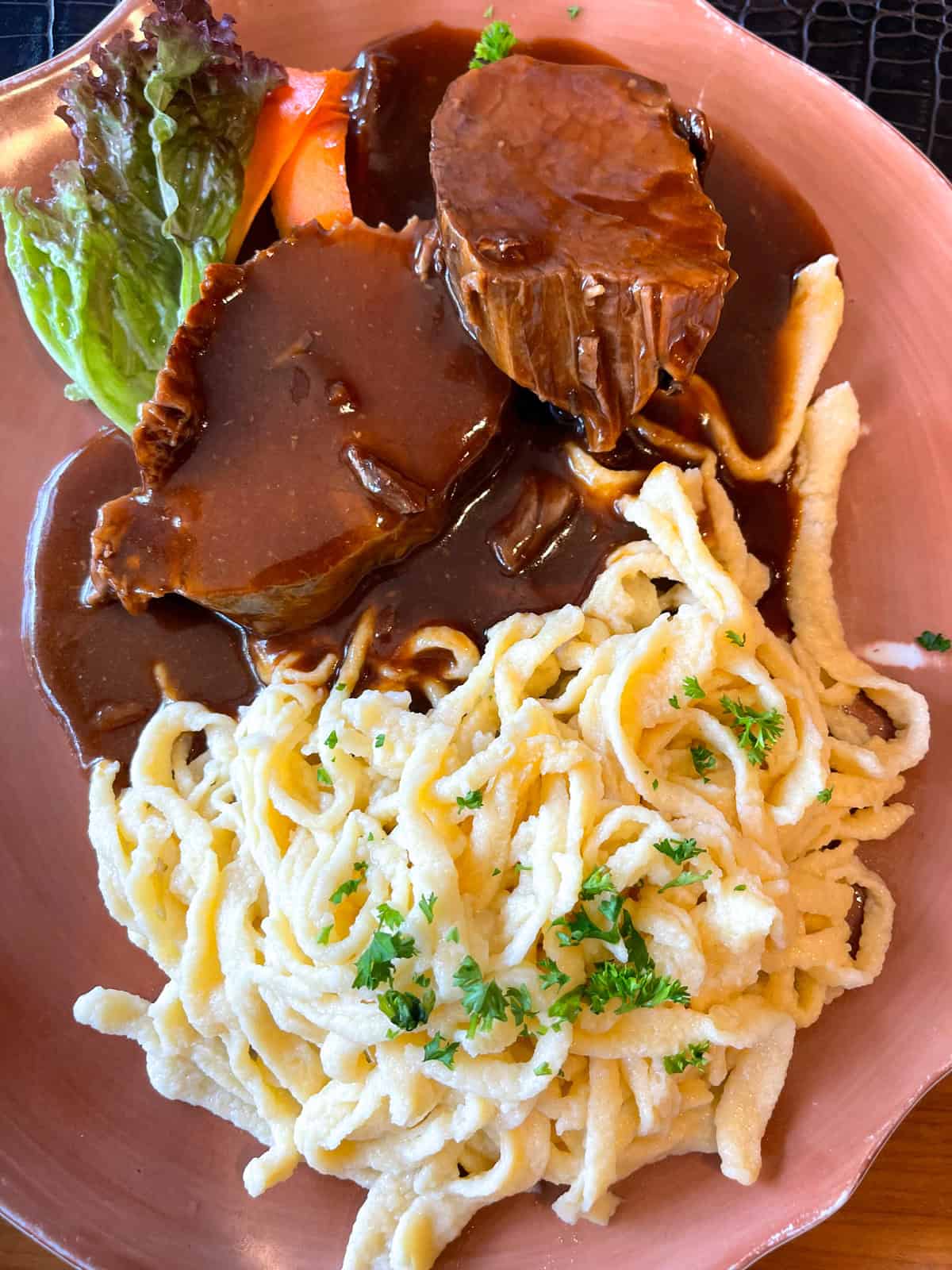
Growing up in southern Germany until moving to the U.S. in my mid-20’s, Sauerbraten was a dish I frequently enjoyed and always looked forward to. Both my Mutti and my Oma would make it served with Rotkohl and either Semmelknödel or Kartoffelklöße, sometimes Spätzle, and it was a memorable feast every time. It was also a dish we enjoyed ordering at restaurants, with each region of Germany adding their own touches and variations.
What is Sauerbraten?
Sauerbraten is a traditional German beef roast that is marinated, browned, and slow-cooked. It is marinated in a mixture of vinegar, wine, spices and herbs over the course of several days which tenderizes the meat and infuses it with its characteristic tangy flavor (hence the name sauerbraten, the German word for “sour roast”).
Sauerbraten is a dish that definitely requires some advance planning as the roast has to marinate for about a week before it’s ready to cook. Don’t cut corners by shortening the marinating time and or holding back on the marinade ingredients. Prepare that amazing marinade, let the meat marinate fully and then reap the rewards for your patience!
Where Did it Originate?
The origin of Sauerbraten has been ascribed to Julius Caesar who is documented as having sent beef marinated in wine all the way from Rome to the new Roman colony of Cologne. Saint Albert the Great of Cologne was later credited with having popularized the recipe in the 13th century. Originally the dish was most commonly made with horse and there are a few restaurants that still serve it, but today it’s primarily made with beef. Less commonly it’s also made with venison or lamb.
This quintessential German dish is found on the menus of many German restaurants both in and outside of Germany. It has been one of Germany’s most popular dishes for generations and as such has become one of its official national dishes.
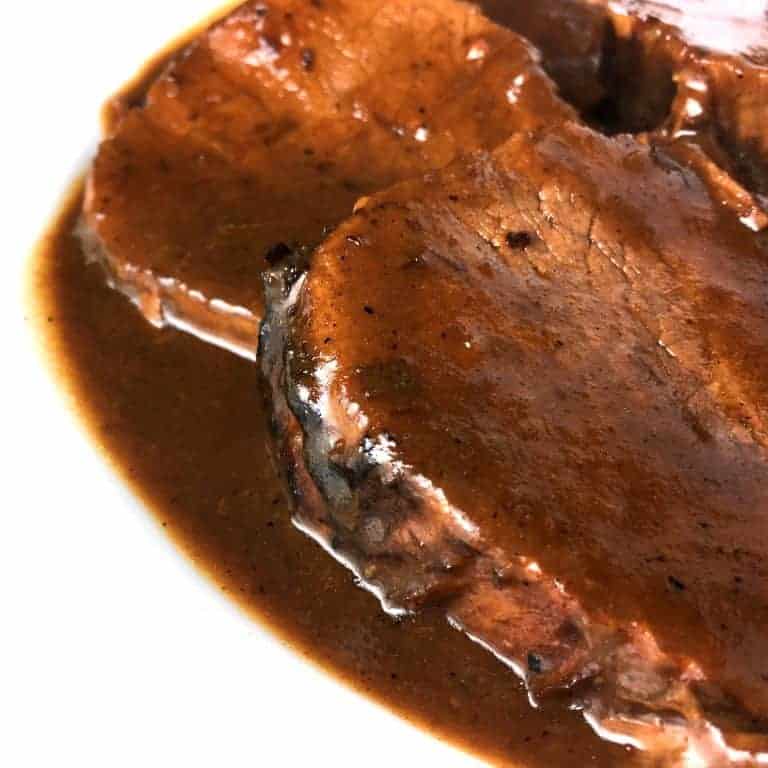
Sauerbraten Ingredients
Sauerbraten recipes vary by region, each adding their own touches. In addition to the sour component there is always the addition of sweet ingredients to balance the acidity and sourness of the sauce. Some regions do this by adding Lebkuchen or ginger snap cookies, raisins, sugar, honey or sugar beet syrup (or often a combination of them) to achieve that balance. To make this traditional Sauerbraten recipe you will need:
- Vegetables: Yellow onions, carrots, leek and garlic go into the marinade and will later be cooked along with the sauce. The leek contributes a fabulous authentic German flavor to the dish so however you may be tempted to omit it, I strongly recommend including it.
- Herbs and Spices: Thyme, rosemary, bay leaves, juniper berries, cloves, peppercorns, salt and sugar all contribute to that authentic Sauerbraten flavor. Juniper berries are very traditional in German cooking, particularly with beef dishes. They contribute a unique woodsy, piney flavor that can’t be replicated any other way. You can buy them online. While I do recommend using them, you can omit them if you can’t find them.
- Red Wine: This forms the bulk of the marinade along with the red wine vinegar. You don’t need an expensive wine because any subtle flavors will be lost in all the seasonings. Choose an inexpensive table wine (but avoid “cooking” wines). Good choices include cabernet sauvignon, merlot or pinot noir.
- Red Wine Vinegar: This creates the “sour” component in Sauerbraten.
- Beef Roast: Tougher cuts like bottom round or rump roast are traditional but you can also use chuck roast for a fall-apart pot roast version.
- Bacon: This is optional and while some variations include it, many do not. I like to include it because that savory-smoky flavor element is fabulous in the final dish.
- Raisins: The inclusion of raisins varies by the region of Germany. Where I’m from in Southern Germany raisins are not included but I occasionally add them because they contribute a really nice flavor and sweetness.
- Ginger Snap Cookies: In Germany things like Lebkuchen or Honigkuchen are traditionally added. Ginger snaps make a great substitute. This adds flavor complexity and sweetness to the dish and also serves as a thickener.
- Honey: This adds sweetness to balance the acidity of the vinegar. Some regions of Germany traditionally use sugar beet syrup instead.
- Flour: To thicken the gravy.
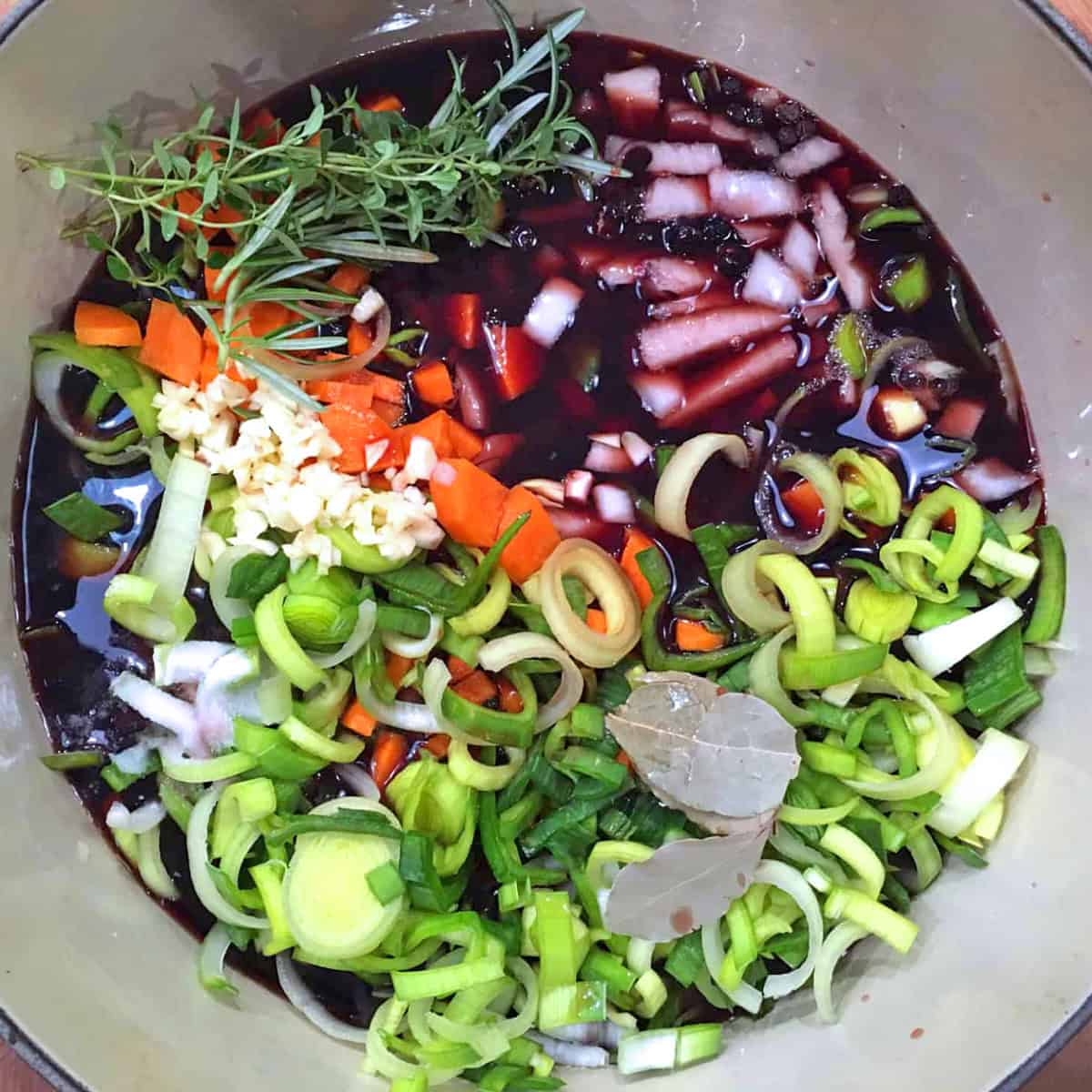
Sauerbraten Recipe
Let’s get started!
Place all of the veggies and herbs in a heavy stock pot or Dutch oven along with the garlic, juniper berries, whole cloves, bay leaves, salt, sugar and peppercorns. Add the red wine, red wine vinegar and water.
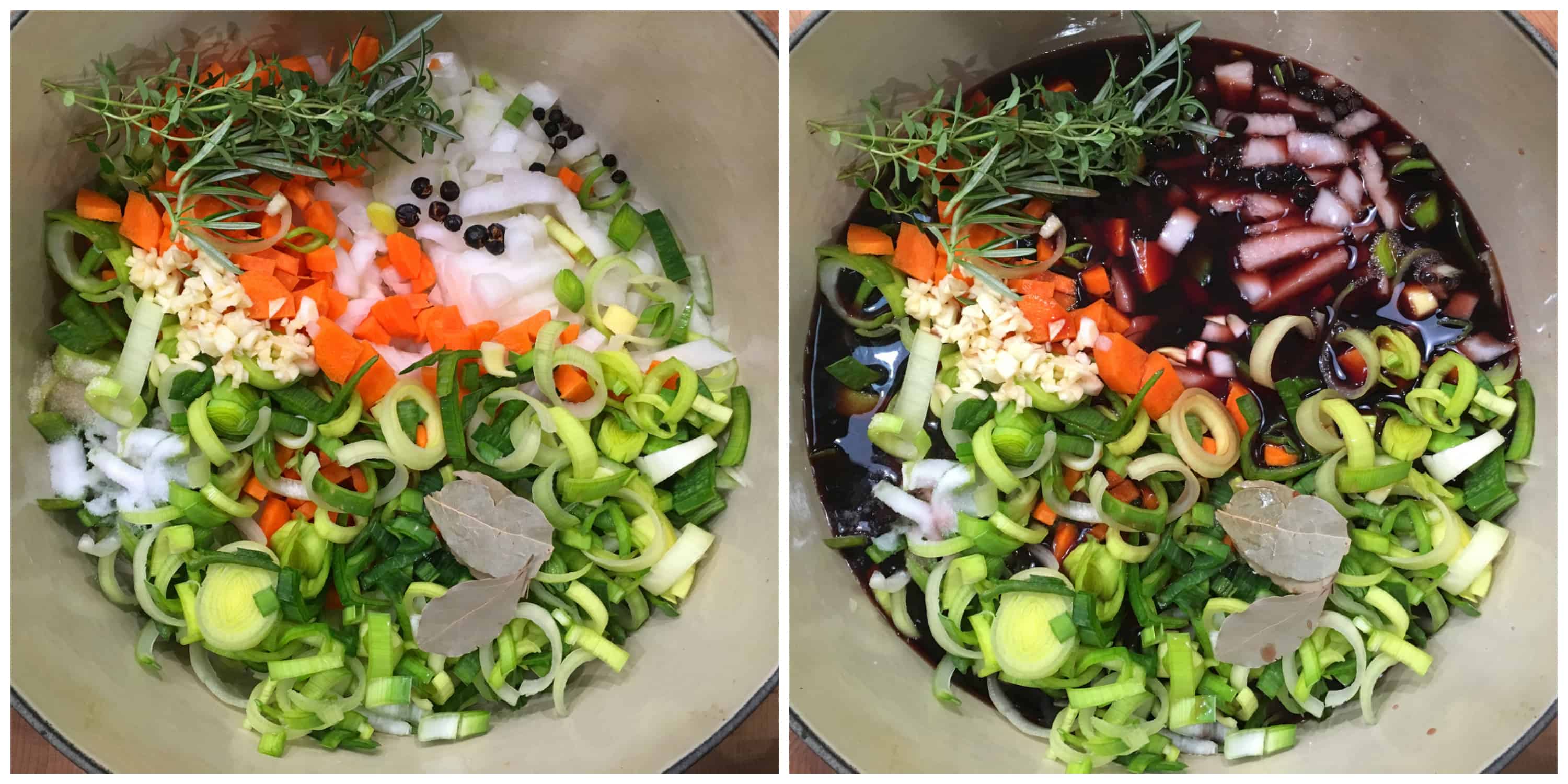
Bring the mixture to a boil, reduce the heat, cover and simmer for 10 minutes. Turn off the heat and let the mixture cool down completely. Nestle the roast in the vegetable marinade and place the lid on the pot.
Let it marinate in the fridge for at least 4 days, preferably 7. (Traditionally, the marinating time is as long as 2 weeks!) Unless the meat is completely submerged under the liquid, turn the roast over once every day.
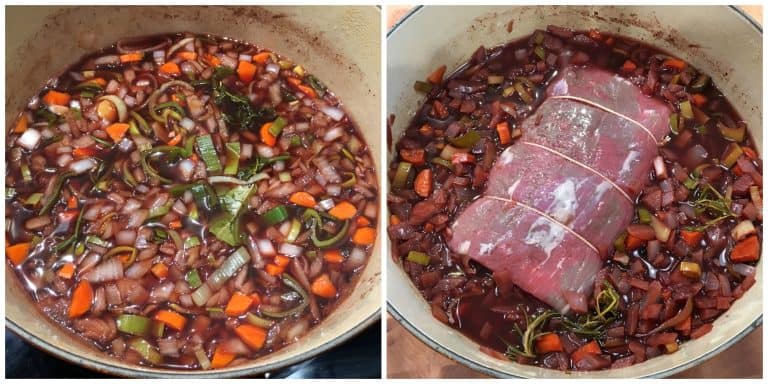
Remove the roast and strain the liquid from the vegetables. Reserve the liquid and the vegetables.
Pat the roast dry with paper towels.
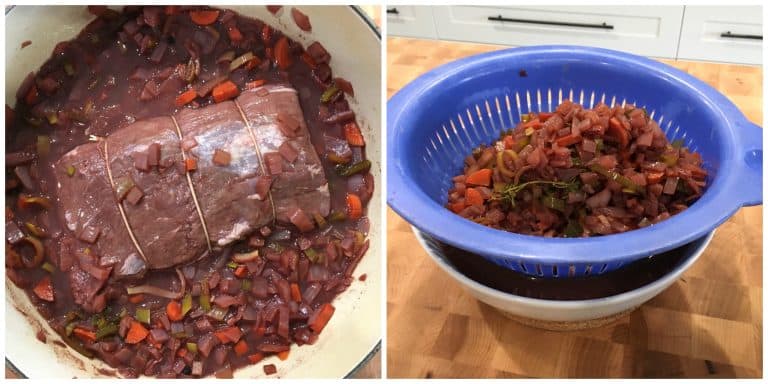
Rinse the pot out and heat a tablespoon or two of oil in it over high heat. Generously brown the roast on all sides.
Remove the roast and set aside. If using bacon, fry the bacon until done.
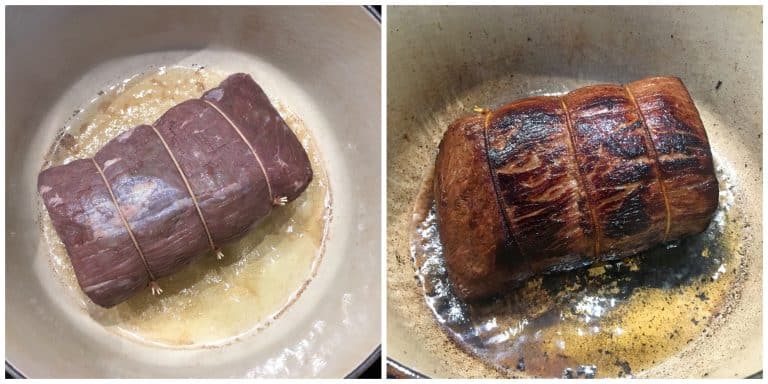
Leave about 2 tablespoons of the oil/fat in the pot. Place the strained vegetables in the pot (along with the bacon if using) and cook for 5-7 minutes. Stir in the flour, cooking the mixture for a minute or two to eliminate the flour flavor. Add the liquid that you strained from the vegetable marinade, bring it to a boil, stirring constantly to prevent lumps.
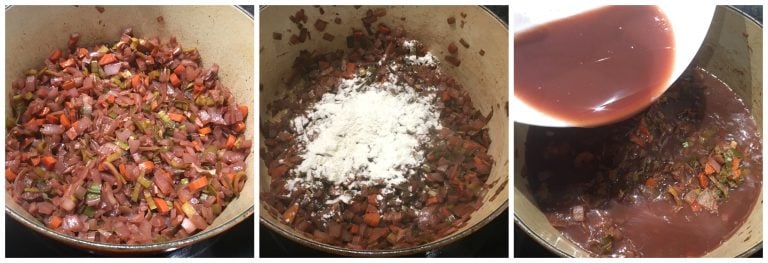
Add the raisins, honey and crushed ginger snaps. Return the roast to the pot.
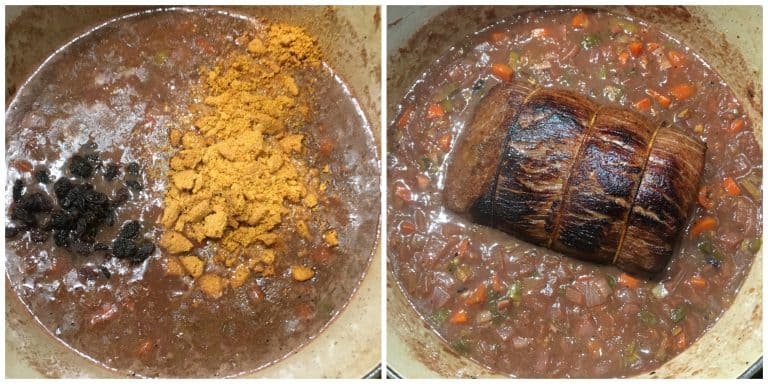
Bring to a boil, reduce the heat to low, cover and simmer for 2-4 hours or until the meat is very tender. Cooking time will vary depending on the type of roast and how long the roast marinated. It takes a while for the tough connective tissues in the meat to get up to temperature to start breaking down, so if the beef isn’t tender continue cooking it.
Note: The longer you let the roast marinate the faster it will cook because the meat will be more tender from the start. So check on your roast periodically for doneness.
When the roast is done, remove and transfer it to a plate and let it rest for 5 minutes before slicing. In the meantime, strain the gravy.
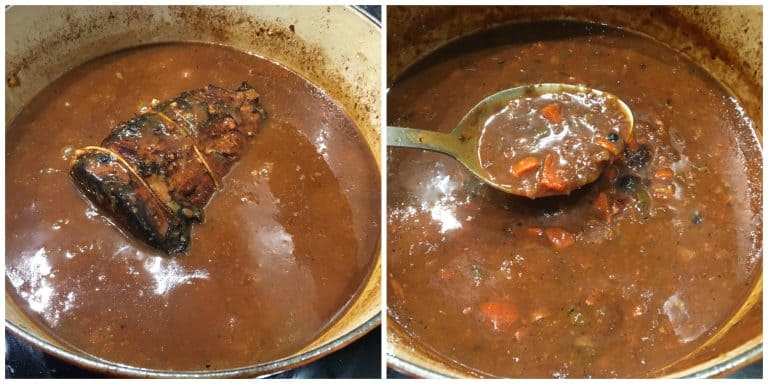
Strain the gravy and return it to the pot. Taste and more sugar, salt and pepper as desired. If you want your gravy thicker, make a cornstarch slurry to thicken the gravy.
Note: The balance of sour to sweet is a matter of personal taste – adjust the flavor according to your preference. If the flavor is too strong for you, you can also dilute it with a little water or broth.
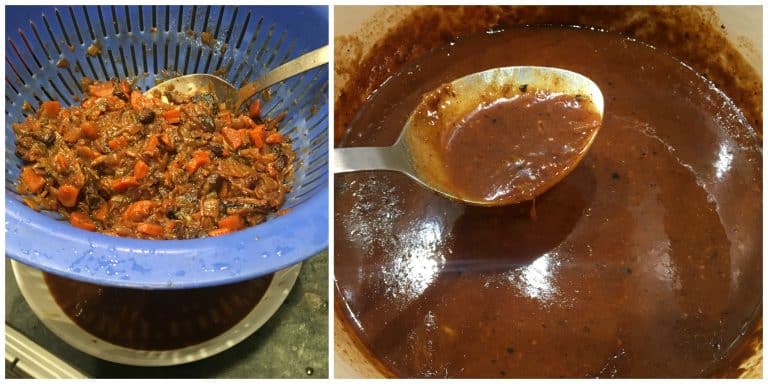
Let the roast rest for 5 minutes after removing it from the pot. Then slice the roast.
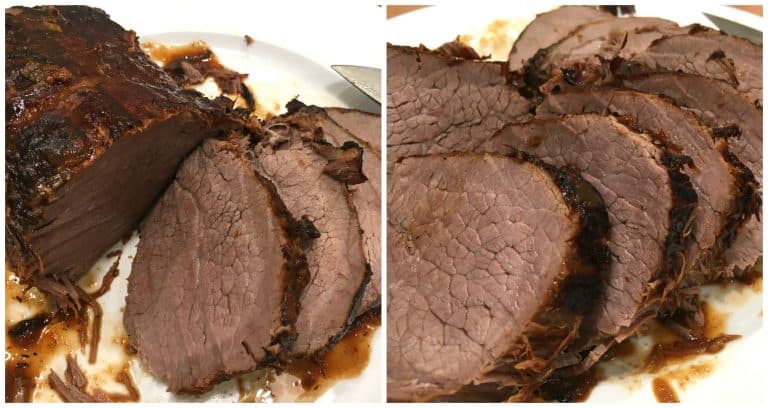
Spoon the hot gravy over the sliced Sauerbraten and serve immediately.

What to Serve with Sauerbraten
There are several traditional sides you can serve with Sauerbraten. These include:
- Kartoffelklöße – these are German potato dumplings and they are popular throughout every region of Germany. They’re made from potatoes and are pillowy soft, making them perfect for mopping up that luscious gravy.
- Semmelknödel – another traditional dumpling, these are bread dumplings seasoned with herbs. These are especially popular in southern Germany where they originated but are served throughout the country.
- Spätzle – the famous noodles from the Swabia region of southern Germany (where I’m from), and when you’re in Baden-Württemberg and order Sauerbraten this is the most popular accompaniment.
- Kartoffelpuffer – where I’m from in Swabia these German potato pancakes are served with sweet accompaniments but in other regions, such as Rhineland-Palatinate, they’re also served as accompaniments to savory dishes, like sauce-based meat dishes. In the case of Sauerbraten, I would serve them in addition to one of the dumpling options or Spätzle.
- Boiled or mashed potatoes – not as exciting as the options above but still perfectly acceptable :)
- Rotkohl – this braised German red cabbage is a must. It is the quintessential traditional side for roast beef in Germany.
- German Potato Salad – definitely the Swabian or Bavarian oil-and-vinegar potato salad varieties, not the mayo-based kind.
- Creamy German Cucumber Salad or the vinegar-based German Cucumber Salad (Gurkensalat) – either of these make a really nice and refreshing accompaniment.
- German Tomato Salad (Tomatensalat) – another refreshing option.
- Bohnensalat – a refreshing green bean salad.
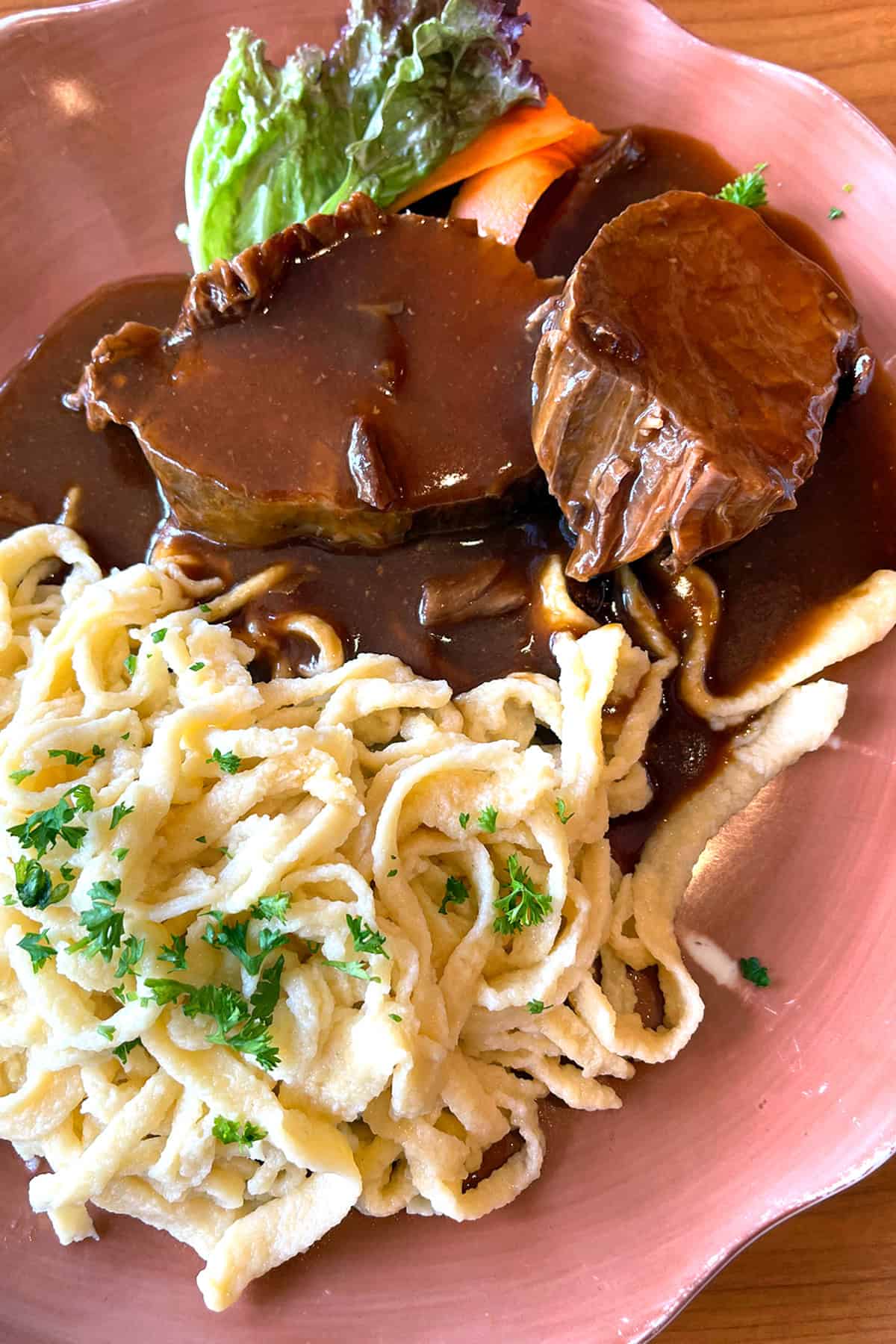
Storage and Reheating
Sauebraten can be made in advance and reheated. I like to pre-slice the meat and store it in some of its gravy to preserve moisture, and then reheat it along with the remaining gravy to serve at the table. It will keep in the fridge for 3-4 days and can be gently reheated in the microwave in a covered container, on the stovetop, in a crockpot, or in the oven.
Sauerbraten can also be frozen. Pre-slice the roast, let it fully cool, and freeze it with the gravy in a freezer-safe container for up to 3 months. Let it thaw slowly in the refrigerator and then gently reheat.
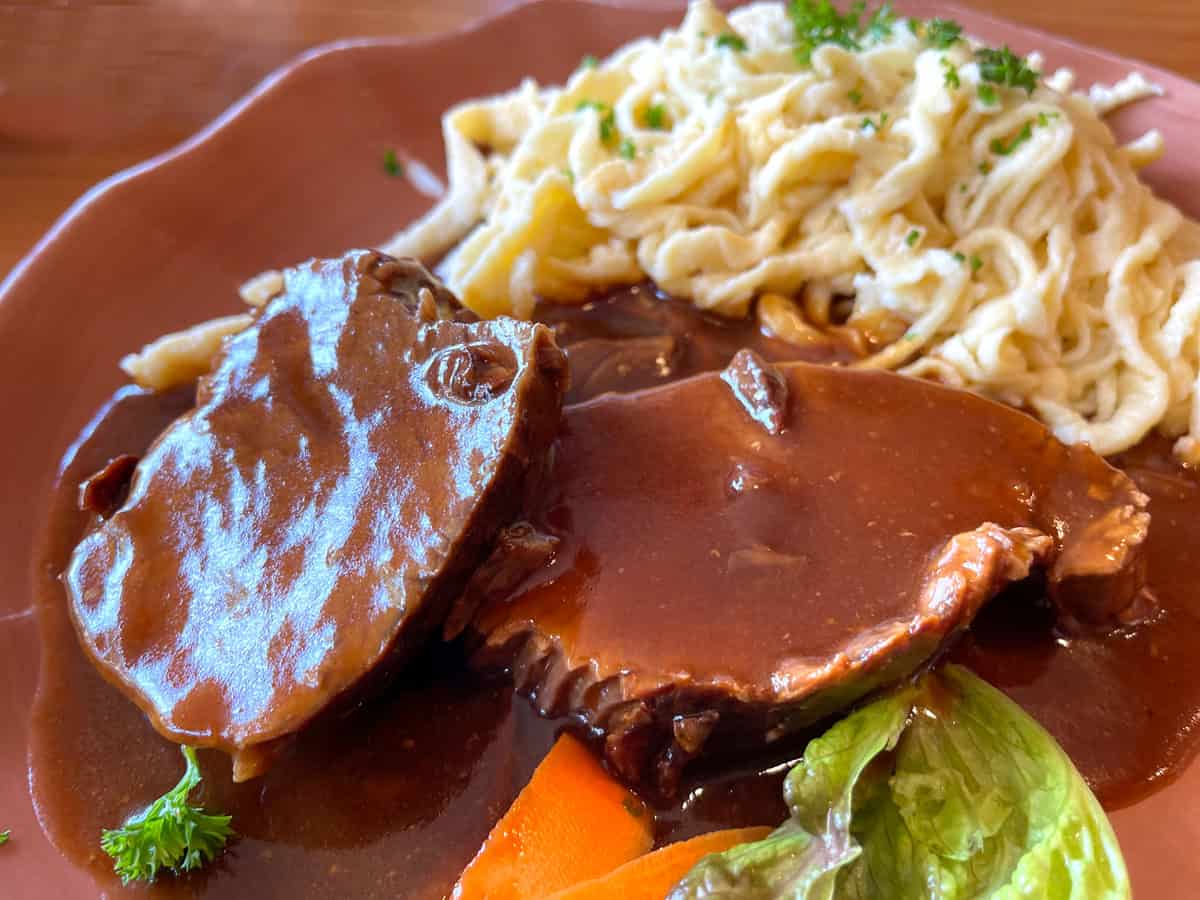
For more delicious German recipes be sure to try my:
- Schnitzel
- Jägerschnitzel
- Königsberger Klopse
- Senfbraten
- Schweinshaxe
- Maultaschen
- German Potato Soup
- Frikadellen
- Currywurst
- Käsespätzle
- German Sauerkraut Soup
- German Bread (Vollkornbrot)
Save This Recipe
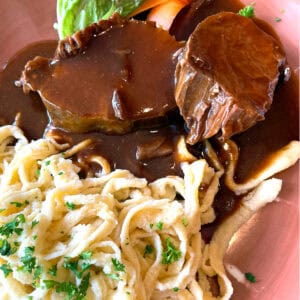
Authentic German Sauerbraten
Equipment
Ingredients
- 2 large yellow onions , chopped
- 2 large carrots , diced
- 1 large leek , chopped, thoroughly washed and drained to remove any dirt
- 3 cloves garlic , minced
- 2 large sprigs thyme , or 1 teaspoon dried
- 2 small sprigs rosemary , or 1 teaspoon dried
- 2 bay leaves
- 8 juniper berries , cracked
- 6 whole cloves
- 10 whole black peppercorns , cracked
- 2 1/2 teaspoons salt
- 1 teaspoon sugar
- 2 1/2 cups dry red wine (e.g., cabernet sauvignon, merlot, pinot noir)
- 1 cup red wine vinegar
- 1 1/2 cups water
- 4 pounds beef roast (tougher cuts like bottom round or rump roast are traditional but you can also use chuck roast)
- 4 slices bacon , finely diced (optional); some variations include but most do not
- 4 tablespoons all-purpose flour
- 1/4 cup raisins
- 3 ounces ginger snap cookies , crumbled
- 1 tablespoon honey
Instructions
- Prepare the Marinade: Place all of the veggies and herbs in a heavy non-reactive stock pot or enameled Dutch oven along with the garlic, juniper berries, whole cloves, bay leaves, salt, sugar and peppercorns. Add the red wine, red wine vinegar and water.Bring the mixture to a boil, reduce the heat, cover and simmer for 10 minutes. Turn off the heat and let the mixture cool down completely.
- Marinate the Meat: Nestle the roast in the vegetable marinade and place the lid on the pot.Let it marinate in the fridge for at least 4 days, preferably 7. (Traditionally, the marinating time is as long as 2 weeks!) Unless the meat is completely submerged under the liquid, turn the roast over once every day.Remove the roast, pat it dry with paper towels, and strain the liquid from the vegetables. Reserve the liquid and the vegetables.
- Cook the Roast: Rinse the pot out and heat a tablespoon or two of oil in it over high heat. Generously brown the roast on all sides. Remove the roast and set aside. If using bacon, cook the bacon until done. Leave about 2 tablespoons of oil/fat in the pot. Place the strained vegetables in the pot (with the bacon if using) and cook for 5-7 minutes. Stir in the flour, cooking the mixture for a minute or two to eliminate the flour flavor. Add the liquid that you strained from the vegetable marinade, bring it to a boil, stirring constantly to prevent lumps.Add the raisins, honey and crushed ginger snaps. Return the roast to the pot.Bring to a boil, reduce the heat to low, cover and simmer for 2-4 hours or until the meat is very tender. Cooking time will vary depending on the type of roast and how long the roast marinated. (Note: The longer you let the roast marinate the faster it will cook because the meat will be more tender from the start. So check on your roast periodically for doneness.)When the roast is done, remove and transfer it to a plate, tent it to keep warm, and let it rest for 5 minutes before slicing.
- Prepare the Gravy: While the roast is resting, strain the gravy and return the gravy to the pot. Taste and more sugar, salt and pepper as desired. If you want your gravy thicker, make a cornstarch slurry to thicken the gravy. (Note: The balance of sour to sweet is a matter of personal taste – adjust the flavor according to your preference. If the flavor is too strong for you, you can dilute it with a little water or broth.)Spoon the gravy over the sliced Sauerbraten and serve immediately.
- Serve with Rotkohl and boiled potatoes, Spätzle, Semmelknödel or Kartoffelklöße . A few parts of Germany even serve it with Kartoffelpuffer.
Nutrition
Originally published October 2, 2018



















Please help me to find juniper berries in Canada?
Hi Susan, some well-stocked health food stores carry them in their spice section. If you have a Whole Foods in your area I would check with them also. And Amazon should definitely have them.
This recipe sounds really good! I’m going to make it asap. However are the juniper berries needed? I’m allergic to juniper.
Hi Allison, no you can omit them and it will still taste amazing :)
Excellent recipe. Made minor changes. Used No salt beef broth instead of water. Added 1 tablespoon pickling spice. Merlot wine. Reduced salt to 1 teaspoon. No bacon.(but it would be tasty)No garlic. (allergic) Marinated 6 days.
Cooked 7 hours in slow cooker on Low.Used 2 cups gingersnap crumbs to thicken gravy. Added two chopped leeks, one sweet onion cut in large pieces and one pound baby carrots.
Before serving stirred in some sour cream. Best pot roast I have ever made in 80 years.
Thank you for a delicious recipe Kimberley.
How would this be to freeze and reheat?
Hi Sharon, it freezes well (pre-slice the meat and freeze in the gravy) and can be reheated on low in the microwave, crockpot or stovetop.
One of the best meals I’ve had, period! OMG, the GRAVY! I’ll be making this again next month when my in-laws come over, they love German food too. Thank you!
That’s wonderful, thank you so much Natasha!
This was absolutely exquisite! I made this for our Sunday dinner last weekend and the whole family loved it. I made it with your spaetzle and rotkohl for a complete meal and we were in heaven. It took us right back to our years in Germany. Vielen Dank, Kimberly!
Oh I’m so glad, thank you Justine!
marinated a 5lb roast for a week and was better than any that I have had before. Roast was a bit too much for the instant pot so I finished it in the oven, next time smaller roast or slow cooker.
Oh I’m so glad, Mike, thank you very much! :)
This was special. We felt like we were dining at one of Germany’s finest restaurants. Really, really wonderful recipe and the gravy was to die for.
Thank you so much, Simone and Tom, I’m happy you both enjoyed it and appreciate the feedback!
I marinated it for 6 days (would have gone the full 7 but the timing didn’t work out) and it was phenomenal. Without hesitation, the best sauerbraten I’ve ever had. I lived a number of years in Germany and this was a favorite dish to order out. Thank you for bringing back memories and giving us one of the best dinners we’ve had.
Thank you so much, Kristina, I’m beyond thrilled to hear that!
How would this be made with a pork loin roast???
Hi Ann, Sauerbraten is made with beef, not pork. But for a really delicious German pork roast you can check out my Senfbraten: https://www.daringgourmet.com/traditional-german-senfbraten-mustard-gravy-pork-roast/
Any way to cook this in an instant pot? I have my meat all marinated for over a week now but was wondering if I could sear it then put it in an instant pot or slow cooker since I’m at work during the day and unable to babysit the kitchen for hours. Any tips?
I had sauerbraten in Germany on multiple occasions when I lived and worked there from 1996-2003. Those were 7 wonderful years and I miss Germany and all the beautiful places we visited and I miss the food. I’ve ordered sauerbraten in German restaurants here in the U.S. is multiple states and while some have been “okay” they just couldn’t come close to what I had in Germany. THIS was as delicious as the best I ever had in Germany. It was like I was back there again. Thank you for this absolutely wonderful recipe!
That warms my heart, Marianna, I’m so happy you enjoyed it and that it brought back fond memories – thank you! <3
I was sure to plan ahead for our Easter dinner by giving this enough time to marinate. We invited our family over and the compliments started the moment they walked in the door and smelled the sauerbraten cooking in the kitchen! I made this with your spaetzle and rotkohl and our German dinner was truly the highlight of our Easter. THANK YOU!
That was a true labor of love, Annette, and I’m so thrilled that everyone your special Easter dinner, thank you!
I am so glad that I found your recipe because it was one of the best things I have ever eaten. My husband and I lived in Germany a number of years ago and this was one of the dishes we regularly ordered when we ate out. I have tried a few recipes over the years but none came anywhere close to this. A++ Teresa and Nathan
Oh I’m so happy to hear that, Teresa and Nathan, thank you very much!
How would you adjust the recipe to omit the wine? I don’t take alcohol so I’d like to make this with just vinegar in the marinade but I’m worried that too much vinegar would make it too sour. Do I substitute vinegar equally by volume in place of the wine or is there a better approach? Also: would grape juice work in place of wine?
Hi Miodek, you definitely don’t want to use vinegar only, you need the balance of flavors. And I wouldn’t use more vinegar than what is called for. Yes you can grape juice instead, I would just use a little less of it since it is so sweet.
Alcohol free wine is available, I’d be worried substituting with grape juice may be too sweet.
When cooking with wine, the alcohol quickly evaporates, leaving just the residual flavors. It will not remind of of alcohol, and will certainly not affect anyone as alcohol would.
Hi Joyce, that’s a common misconception. It’s true that heat and length of cooking reduces some of the alcohol content, but definitely not all. For someone who is a recovering alcoholic, for example, I would never want them to think that cooking something makes it alcohol free, because it doesn’t.
https://www.americastestkitchen.com/articles/7681-can-you-cook-off-the-alcohol-from-food-ask-paul